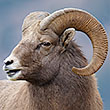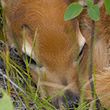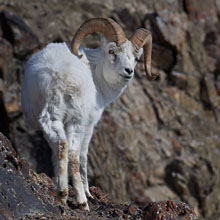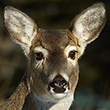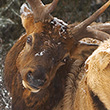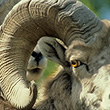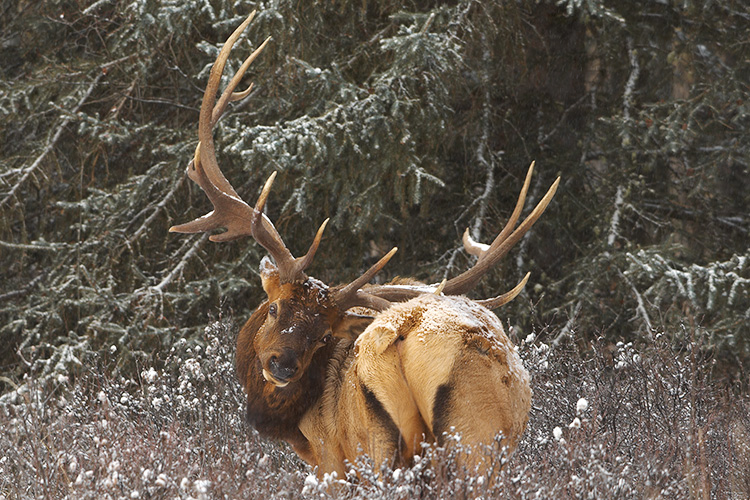
Availability: Undetermined - Enquiries?
In the Field
Antlers in Action. Banff National Park, Banff, AB, Canada. November 6, 2005.
Evolution (or, if you'd prefer, the creator) has developed some pretty odd anatomical structures. Antlers would definitely rate highly on the oddness scale. If you've ever lifted up a set of them (especially massive ones like those shown in this image), you'll realize that they can be amazingly heavy (and cumbersome). Imagine walking through a thick forest with these things attached to your head!
So, it was pretty interesting to watch this bull Elk put his antlers to good use - who doesn't like a good back scratch? It might almost be worth the pain of living with these things on your head for part of each year!
Behind the Camera
Antlers in Action. Banff National Park, Banff, AB, Canada. November 6, 2005.
Digital Capture; Compressed RAW (NEF) format; ISO 200.
Nikon D2X with Nikon 200-400 mm f/4G ED-IF AF-S VR lens @ 310 mm (465 mm equivalent with digital conversion factor) supported on bean bag. VR turned to "On" and in "Normal" mode.
1/60s @ f5; -0.67 stop compensation from matrix-metered exposure setting.
At the Computer
Antlers in Action. Banff National Park, Banff, AB, Canada. November 6, 2005.
RAW Conversion to 16-bit TIFF, including first-pass sharpening, exposure compensation, and tone curve adjustment, using Phase One's C1 Pro.
All further digital correction on 16-bit TIFF file using Adobe's Photoshop CS2, including tone curve adjustment, selective saturation enhancement and selective sharpening for web output.
Conservation
Antlers in Action. Banff National Park, Banff, AB, Canada. November 6, 2005.
Ten percent of the revenue generated by this image will be donated to the Yellowstone to Yukon Conservation Initiative.
Species Status in Canada*: This species is not designated as at risk.
Elk (Cervus elaphus) are now common again in much of western North America - in fact elk now are found in more habitats and in higher numbers (approaching a million animals) than any other time since 1900. The future on elk populations in North America seems secure.
This bull elk was photographed in Banff National Park. While this species is not currently not considered at risk, the region this herd was photographed in is considered as of significant importance in maintaining genetic connectivity between northern and southern populations of bighorns.
The Yellowstone to Yukon (Y2Y) Conservation Initiative seeks to ensure that the world-renowned wilderness, wildlife, native plants, and natural processes of the Yellowstone to Yukon region continue to function as an interconnected web of life, capable of supporting all of its natural and human communities, for current and future generations.
*as determined by COSEWIC: The Committee on the Status of Endangered Wildlife in Canada


















